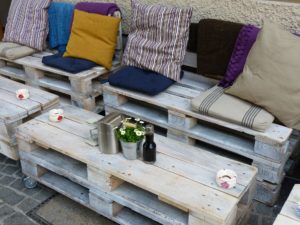Even though it may feel like fall has just begun, whether we like it or not, winter is going to happen. The clocks have been rolled back and the shorter, darker days of winter are here.
Before you hunker down for the colder temperatures, if you take a little extra time to care for your backyard patio furniture now, you’ll save yourself a lot of additional work come spring.
Take Inventory
Cushions, pillows and umbrellas should be the first to be packed up and stored. Although the newer outdoor fabrics are designed to resists mildew in an outdoor setting, if the fabric is bagged while even a little damp, you’re practically asking for mildew. Spot clean any stains according to the manufacturer’s instructions and leave them out to dry on a sunny day. Once they are totally dry, bag them in a trash bag for storage. Or better yet, use an old sheet to allow air to circulate completely over the winter months. If you can, hang them up to make it harder for pests to make your cushions their winter hideaway.
Furniture

While some patio furniture and lawn products are manufactured to remain outdoors for the winter, if you can, move it indoors into a garage or shed. The less exposure to the elements it has, the longer it will last.
- Wrought Iron
Sturdy as it is beautiful, wrought iron stills needs care. This classic patio furniture is susceptible to rust; and because of its weight, you’ll most likely be keeping it on the patio throughout the winter. Before you cover it, be sure to remove any rust that’s accumulated on it with a stiff wire brush. A coat with a good rust inhibiting exterior spray paint designed for wrought iron should keep it protected it during the months to come. Invest in a good quality tarp to protect it from ice and snow.
- Aluminum
These days, almost all aluminum patio furniture has been powder coated to keep it from rusting. For added protection (after washing it down) apply a coat of automotive wax before you pack it up this fall. The truly ambitious can touch up scratches with car paint.
- Plastic
Depending on how much dirt has accumulated, clean your plastic furniture with either warm soapy (dish detergent) water or Simple Green. Plastic will become brittle and crack in extreme cold, so it’s best to bring it indoors for the winter.
- Rattan
Give rattan a good blast with a hose or power washer to get any built up dirt out of the crevices. Make sure to check the underside, as insects love rattan’s southern charm too.
Patio Pavers
Synthetic wicker can stay outdoors if covered, but natural rattan should be kept in a dry space. Both should be kept covered to prevent dust and dirt from settling in the crevices.

Patio pavers are manufactured using cement, so they can stain temporally if not cared for properly. The most common stain on backyard patio pavers occurs when a metal is left standing in the same place over a long period of time. Both wrought iron furniture and grills have been known to leave rust stains on pavers and cement patios.
To save yourself from an arduous cleaning project come spring, remove anyrust (see above) and spray metal patio legs with a clear acrylic spray. Cap metal parts that touch the pavers with outdoor furniture tips.